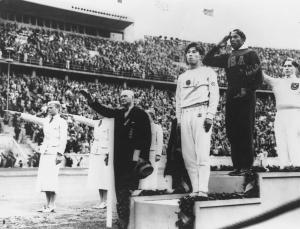|
Close your eyes and try imagining a sad person. What do you see? The face of a crying woman? A blurry image of a screaming man? Or a depressed man resting his chin on his hand? Whatever image you have in your mind right now, it is a very high possibility, to have been heavily influenced by art. There is no doubt that visual art has a very strong influence over us, to the extent of shaping the way we understand our own emotions. Maybe you might disagree with this. Then here’s a question for you. Would people from a thousand years ago imagine sadness, or emotional pain in general, the same way we do now? The answer is…. probably not. |
|
Ancient Greece ‘Laocoon Group’, Hagesander, Athenodoros, Polydorus, 42-20 B.C. One of the most famous sculptures of ancient Greece, the ‘Laocoon Group’, depicts the Trojan priest and his two sons being punished by the gods. The sculpture, originally made of colored bronze, strikingly portrays a scrunched up face screaming in agony. Besides this masterpiece, there are many other sculptures from ancient Greece that openly show their pain and sadness. These sculptures have something in common: the subjects are non-Greek, deserving to be punished by the gods, or are beastly creatures. In contrast, almost all imagery representing the good Greeks (be it the gods or heroes) never openly express sadness, or any emotions. As ancient Greeks were such lovers for balance and harmony, we can vaguely assume that open expressions meant chaos and barbarism, while the emotionless face represented balance and civilization. We can imagine that maybe, the ideal image of a sad person in ancient Greece was that of a Homeric[1] hero, honorably accepting his tragic destiny with a balanced demeanor.
Medieval Europe ‘Battle of Aljubarrota’, Jean de Wavrin, late 15c. Medieval Art from the 5th to 15th century of Europe, is such an obscure subject, due to its longevity and vast features. Nonetheless, we can find repeated images of stoic, boring faces. ‘Battle of Aljubarrota’ shows the battle between the Kingdom of Portugal and the Crown of Castile. To our eyes, the completely emotionless soldiers amidst harsh battle seems so unnatural, even humorous. This might seem even more strange, if you know the fact that the people of Medieval times were very emotional. Then why does Medieval imagery seem to lack emotion? Though no one really knows, we can make some guesses. Early Christians believed that realistic depictions of anything could cause idolatry[2]. This made the artists paint in abstract forms, in order to make a clear difference between the real and the image. Naturally, realistic depictions of facial expressions were shunned. Besides, Christianity during Medieval times was so deeply imprinted on the people, that literally everything, including all encouraged emotions, were believed to be given by God. This might have led artists to be obsessed with Christian iconography[3], but uninterested in depicting humane emotions. The image of sadness by this time, might have been an abstract, emotionless depiction of a scene from the Bible, where someone was in duress while being tested by God.
The Renaissance ‘Melencholia I’, Albrecht Dürer, 1514 In the 12th and 13th century, the famous Greek philosopher Aristotle’s works were retranslated into Latin, stimulating the revival of Aristotelianism in western Europe and continued into the Renaissance. The ancient Greek term “melancholia”, meaning a state of low mind or a depressive disorder, was also reconsidered during this time. In one of Aristotle’s remarkable works, he links melancholia and outstanding achievement, explaining that melancholia sometimes enhances creativity in a broad range of fields[4]. To many elites in the Renaissance period, sadness wasn’t just depression anymore. It became a driving force for achievement, and an essential quality of a genius. This also encouraged artists, who were more than ready to prove that they were highly educated just like scholars. Albrecht Dürer’s ‘Melencholia I’ depicts an angel in depression, surrounded by tools that represent various fields of sophisticated studies. The angel is the embodiment of melancholia, which allows elites to contemplate or philosophize intellectual matters. Her posture, sitting down and resting her chin on her hand was a repetition of the iconography of melancholia. This iconography was repeated over and over throughout the Renaissance so much, that if you asked about sadness to Renaissance people, they probably would’ve imagined this posture immediately.
Early Realism ‘The Third of May 1808’, Francisco Goya, 1814 After the Renaissance, came the dawn of modernity. The 18th century was the age of enlightenment and revolutions. This made a huge difference in the lives of Europeans. Humanity became what was important, and the old authority was no longer welcomed. People were finally taking interest in the real human world. Francisco Goya, one of the very first modern painters, was one of them. ‘The Third of May 1808’ portrays Spanish captives just about to be executed by Napoleon’s army. Unlike most of the war images from before, Goya highlights the agony of powerless victims. Furthermore, the man in the white shirt, probably a laborer, is portrayed with so much admiration, that he even holds a holy aura. It is very obvious that Goya wanted viewers to sympathize with the victims, rather than the oppressive soldiers. After this revolutionary piece of painting, many other artists attempted to capture the realistic sorrow of commoners, resulting in the Realism art movement. This indicates that ordinary people were gaining a voice, and their lives and emotions were being acknowledged as something important. This was a huge difference from the Medieval times when almost every painting was about God, or the rich ruling class. Sadness at this time could’ve been the general image of commoners’ lives, which derives from the real problems of the world.
Expressionism
The late 19th century and the early 20th century was a bipolar era. Rapid development of technology created remarkable metropolises. But where the light was strongest, so too was the darkness. The surge in the suicide rate, the prevalence of prostitution, the rise of alienation, and stress all indicated the lack of interaction between metropolitans. These all broke down into the catastrophic First World War. Here, people were introduced to the terror of tanks and chemical weapons. Massacres became so easy to happen. During this chaotic state, young German artists sought ways to express their pain. They were the Expressionists, who painted not what they saw, but what they felt. Rough brushstrokes and strong colors, unfamiliar compositions and distorted figures were all carefully selected methods to express emotions better. Ernst Ludwig Kirchner’s ‘Self Portrait as a Soldier’ is a great example of this. This was created right after Kirchner’s traumatic experience in the war as a driver. He depicted himself with a severed right hand, as a metaphor for his inner fear of the world and loss of identity. It seems like the madness and anguish of the war and metropolises was what people from the early 20th century imagined as emotional pain. |
|
I hope this explanation of artwork helped you understand the question “would people from the past imagine sadness the same way we do now?” Now we know that the way art portrayed emotions has changed throughout history. It reflected the thoughts of people at that time, and also indoctrinated[5] particular ideas to them. This is the power of art. It explains who we are, and at the same time, forces us to think in certain ways. Then, I have another question for you. How much of your thoughts are truly yours? |
[1] Homeric: relating to or in the style of Homer or the epic poems ascribed to him
[4] Marlies ter Borg. “Aristotle on Melancholy”. 2013. p.2.
[5] indoctrinate: to often repeat an idea or belief to someone in order to persuade them to accept it.
Lee Giwon jlee1402@naver.com
<저작권자 © 홍익대영자신문사, 무단 전재 및 재배포 금지>





